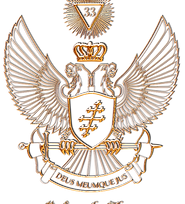Deus Meumque Jus
- 2 Ιαν 2016
- διαβάστηκε 3 λεπτά

The main inscription of Scottish Rite is the phrase: Deus Meumque Jus
We find it openly on the banner held by Goddess figure ( The Goddess of Freemasonry) under the statue of Pike
The statue of Pike is the only outdoor sculpture in Washington, D.C. honoring a Confederate general, although he is dressed as a civilian, not a soldier.
It is located in Reservation 188 at the southwest corner of 3rd and D Street NW in the Judiciary Square neighborhood.
The bronze sculpture of Pike measures 3.4 m high and depicts him as a Masonic leader, not a Confederate officer.
He is wearing a double-breasted vest and a long coat.
His right arm is extended and with the left hand he holds a book, thought to be his work Morals and Dogma of the Ancient and Accepted Scottish Rite of Freemasonry.
On the front of the memorial (north side), a bronze sculpture representing the Goddess of Masonry rests halfway down the base. With her right hand, she holds the banner of the Scottish Rite on a staff. She is wearing a long Greek robe and facing downward, her ankles crossed and feet dangling.
Richard the Lionheart
But according to the legacy, the origin of the inscription comes from the coat of arms of Richard the Lionheart, (Richard I of England).
Richard I (8 September 1157 – 6 April 1199) was King of England from 6 July 1189 until his death. He also ruled as Duke of Normandy (as Richard IV), Duke of Aquitaine, Duke of Gascony, Lord of Cyprus, Count of Poitiers, Count of Anjou, Count of Maine, Count of Nantes, and Overlord of Brittany at various times during the same period. He was the third of five sons of King Henry II of England and Eleanor of Aquitaine. He was known as Richard Cœur de Lion or Richard the Lionheart because of his reputation as a great military leader and warrior. He was also known in Occitan as Oc e No (Yes and No), because of his reputation for terseness.
By the age of 16, Richard had taken command of his own army, putting down rebellions in Poitou against his father.
Richard was a central Christian commander during the Third Crusade, leading the campaign after the departure of Philip II of France and scoring considerable victories against his Muslim counterpart, Saladin, although he did not retake Jerusalem from Saladin.
Corfu and Captivity
Bad weather forced Richard's ship to put in at Corfu, in the lands of the Byzantine Emperor Isaac II Angelos, who objected to Richard's annexation of Cyprus, formerly Byzantine territory. Disguised as a Knight Templar,

( Coin issued by Richard I with distinct Templar influence.)
Richard sailed from Corfu with four attendants, but his ship was wrecked near Aquileia, forcing Richard and his party into a dangerous land route through central Europe. On his way to the territory of his brother-in-law Henry the Lion, Richard was captured shortly before Christmas 1192 near Vienna by Leopold V, Duke of Austria, who accused Richard of arranging the murder of his cousin Conrad of Montferrat. Moreover, Richard had personally offended Leopold by casting down his standard from the walls of Acre.
Legacy
Richard's reputation over the years has "fluctuated wildly", according to historian John Gillingham.
Richard's contemporaneous image was that of a king who was also a knight, and that was apparently the first such instance of this combination.
He was known as a valiant and competent military leader and individual fighter, courageous and generous.
According to the History

According to the preserved coat of arms, we find this inscription ( written in French Dieu et mon Droit.) on the coat of arms of THE HOUSE OF STUART (1603 - 1714)
(They had already ruled as the royal family of Scotland since 1371)
The inscription maintains to the HOUSE OF HANOVER (1714 - 1901) Between 1714 and 1837, Britain and Hanover were united under one monarchy

and THE HOUSE OF WINDSOR (1901 - Present)
Known as "the House of Saxe-Coburg" between 1901 and 1917.


Σχόλια